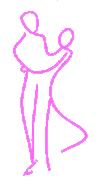 |
ROUND DANCING — CHOREOGRAPHED BALLROOMEDUCATIONAL ARTICLESMAJOR SECTIONS: Figures | Articles | Links | Alph. Index | Search | Home |
|
|
All About Whisksby Roy & Phyllis Stier Whisks have an extensive family. There are several kinds but many ways to perform them, not to mention whisk "lines." Let's have a look at the more common varieties. The so-called "flat Whisks" are the Fallaway and the Left, although the dancers must still articulate the heel, toe/heel, toe/heel sequence. Flat in this case means that the crossing behind on step 3 will lower to heel as the step is taken (no body rise). The other two basic Whisks are the standard, or garden variety, and the Back Whisk. They both call for a continuation of rise on step 2 and an up position on step 3 with body rise ready to lower for the next figure. The standard Whisk is usually taken from a closed position diagonal to wall. The man places his left foot directly in front of his right on step 1 (lady just back R). She will make a 1/8 + 1/8 right-face turn as she steps diagonally back on her left and then crosses her right in back to blend to semi-closed position. Note: the man is still facing diagonal wall as he uses a left sway (lady R) on steps 2 and 3 to rise in a sort of platform mode with front poise ready to lower for the next figure. Now, if we wish to end in semi-closed position facing diagonal center for a Weave, Cross Hesitation, etc., the man will make the 1/4 left face turn as the lady stays put — the technique of body mechanics is still the same.A Back Whisk is usually taken from a contra-banjo position, where the man steps straight back on step 1 as the lady starts a right-face turn; then he steps diagonally back on his right as the lady steps side left. Step 3 is the crossing behind for both, but the lady must continue her right-face turn as she blends to semi-closed position. This would normally not change direction for the man. Some folks confuse the Fallaway and the Back Whisks, but since "fallaway" means stepping back in semi-closed position, this should be the primary criterion (in the Back Whisk, the lady is still turning). Usually, the fallaway requires quite a turn, particularly for the man (right-face), but sometimes it is initiated by the lady, such as following a Left Whisk. In any event, it needs a crossing in back from semi-closed position and is of the "flat" variety. The Left Whisk is a little more unique because the man feels like he is leading the lady from semi-closed position to a Wing, but does take steps 2 and 3 (L, R) to the side, then crossing behind as his body turns toward the lady. She has a turn of approximately 3/8 left-face as she makes most of it on step 2, then continues to turn while crossing her left in back of right. She must turn a little away from the man as he allows his upper body to turn farther left-face than his foot position. Whisks are used in most rhythms — in the typical flat Whisk of the tango (Q, Q, S), the S/& S; tempo of the samba, but only as a "line" in rumba. It can be syncopated as in the waltz (1, 2/&, 3), or turned to a new dance position. Interpretation in quickstep is usually S, Q, Q; but can be S, S; S, at times. In our familiar two step, it is done in Q, Q, S; timing, as well as the foxtrot S, Q, Q; rhythm. In any event, the key is to characterize the dance using the bounce of the samba, the smoothness of the foxtrot, the lightness of the quickstep, etc. Quite a family, wouldn't you agree?
This column comes from a series published in Cue Sheet Magazine between 1987 and 1992, and is reprinted with permission. The full series is collected in an 86-pg booklet, available for $30.00 plus postage. E-mail Fran Kropf at cutecuer@cox.net. This article was published in the Dixie Round Dance Council (DRDC) Newsletter, December 2008.
|
 |
|
|
Page last revised